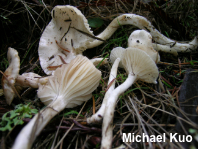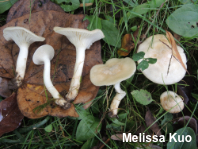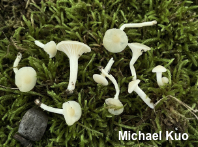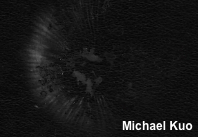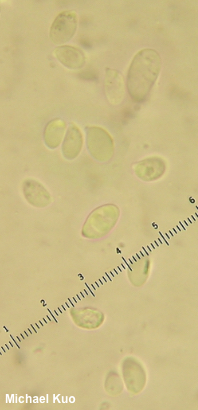| Major Groups > Gilled Mushrooms > Pale-Spored > Waxy Caps > Cuphophyllus virgineus |

|
[ Basidiomycota > Agaricales > Hygrophoraceae > Cuphophyllus . . . ] Cuphophyllus virgineus by Michael Kuo, 27 November 2022 Cuphophyllus virgineus is a small to medium-sized, whitish waxy cap that features a dry to greasy cap, a dry stem, and gills that run down the stem. Its cap sometimes develops brownish or yellowish shades, especially over the center. Cuphophyllus borealis (formerly Hygrocybe borealis) is very similar but features a sticky cap and, under the microscope, a corresponding ixocutis. Cuphophyllus russocoriaceus is also similar, but features a strong odor of cedar wood. Synonymies and taxa separated on minor differences abound, and, according to Boertmann (2000), Two varieties of Cuphophyllus virgineus, ochraceopallidus and fuscescens, are often found in waxy cap literature—the former with yellowish colors and a stouter stem (perhaps like the specimens in the second illustration), and the latter with a brownish cap center. Hygrocybe virginea, Camarophyllus virgineus, and Hygrophorus virgineus are synonyms. Hygrocybe nivea (AKA Hygrophorus niveus and Camarophyllus niveus) was formerly separated on the basis of its smaller size and striate cap margin (see the third illustration), but has been reduced to synonymy by Arnolds (1986). Description: Ecology: Precise ecological role uncertain (see Lodge and collaborators 2013); growing scattered or gregariously in grasslands (in Europe) or in disturbed-ground areas in woods under hardwoods or conifers (North America); summer and fall, or over winter in warmer climates; originally described from Austria (von Wulfen 1781); widely distributed in Europe and in North America. The illustrated and described collections are from California and Illinois. Cap: 1–5 cm across; convex when young, becoming broadly convex to more or less flat—or developing a shallow central depression and an uplifted margin; moist to slightly lubricous when fresh, but soon dry; hygrophanous; bald; white to ivory, but sometimes becoming yellowish, or developing brownish to yellowish areas over the center—or sometimes yellowish throughout development. Gills: Running down the stem; distant or nearly so; whitish, becoming pale yellowish with age; short-gills frequent. Stem: 2–12 cm long; 3–10 mm thick; often tapering to base; dry; bald or nearly so; whitish to faintly yellowish; discoloring brownish toward the base with age; becoming hollow. Flesh: White; unchanging when sliced. Odor and Taste: Odor not distinctive; taste not distinctive, or a little bitter. Chemical Reactions: KOH yellowish on cap surface. Spore Print: White. Microscopic Features: Spores 6–10 x 4–5 µm (smaller in some forms); ellipsoid to lacrymoid, with an apiculus; smooth; hyaline in KOH; inamyloid. Basidia 45–60 x 5–7 µm; subclavate; 4-sterigmate. Cystidia not found. Lamellar trama interwoven. Pileipellis a cutis or ixocutis; elements 2–5 µm wide, smooth, hyaline in KOH; clamp connections present. REFERENCES: (F. X. von Wulfen, 1781) A. E. Kovalenko, 1989. (Kauffman, 1918; Hesler & Smith, 1963; Bird & Grund, 1979; Smith, Smith & Weber, 1979; Largent, 1985; Arnolds, 1986; Breitenbach & Kränzlin, 1991; Schalkwijk-Barendsen, 1991; Phillips, 1991/2005; Candusso, 1997; Barron, 1999; Boertmann, 2000; McNeil, 2006; Miller & Miller, 2006; Trudell & Ammirati, 2009; Boertmann, 2010; Bessette et al., 2012; Buczacki et al., 2013; Lodge et al., 2013; Kuo & Methven, 2014; Desjardin, Wood & Stevens, 2015; Siegel & Schwarz, 2016; Boertmann, 2018; Læssøe & Petersen, 2019; Kibby, 2020; Wood & Dunkelman, 2020; McKnight et al., 2021.) Herb. Kuo 01130505, 10131801, 09082201. This site contains no information about the edibility or toxicity of mushrooms. |
© MushroomExpert.Com |
|
Cite this page as: Kuo, M. (2022, November). Cuphophyllus virgineus. Retrieved from the MushroomExpert.Com Web site: http://www.mushroomexpert.com/cuphophyllus_virgineus.html |
